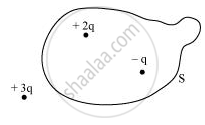Advertisements
Advertisements
प्रश्न
Consider a uniform electric field E = 3 × 103 `bbhat i` N/C.
- What is the flux of this field through a square of 10 cm on a side whose plane is parallel to the yz plane?
- What is the flux through the same square if the normal to its plane makes a 60° angle with the x-axis?
उत्तर
- Area of square, A= a2 = 102 = 100 cm2
= 100 × 10-4 m2
= 10-2 m2
Since the plane lies on the y-z-axis, area vector `vecA` points in the same direction.
i.e., `vecA = (10^-2 hati) "m"^2`
∴ Electric Flux through the square is
Φ = `vecE · vecA`
= `(3 xx 10^3 hati) · (10^-2 hati)`
= 3 × 101
or Φ = 30 V-m - When normal to plane i.e., A makes an angle of 60° with E, then
Φ' = EA cos 60°
= 3 × 103 × 10-2 × 1/2
= 1.5 × 101
or Φ' = 15 V-m
APPEARS IN
संबंधित प्रश्न
How does the electric flux due to a point charge enclosed by a spherical Gaussian surface get affected when its radius is increased?
Figure shows three point charges +2q, −q and + 3q. Two charges + 2q and −q are enclosed within a surface ‘S’. What is the electric flux due to this configuration through the surface ‘S’?

It is said that any charge given to a conductor comes to its surface. Should all the protons come to the surface? Should all the electrons come to the surface? Should all the free electrons come to the surface?
If the flux of the electric field through a closed surface is zero,
(a) the electric field must be zero everywhere on the surface
(b) the electric field may be zero everywhere on the surface
(c) the charge inside the surface must be zero
(d) the charge in the vicinity of the surface must be zero
The following figure shows a closed surface that intersects a conducting sphere. If a positive charge is placed at point P, the flux of the electric field through the closed surface

Choose the correct answer from given options
The electric flux through a closed Gaussian surface depends upon
If the flux associated with a coil changes at the rate of 360 webers every 4 minutes, then the induced e.m.f. is ______
The SI unit of electric flux is ______.
An electric charge q is placed at the centre of a cube of side a. The electric flux on one of its faces will be ______.
The electric field intensity due to an infinite cylinder of radius R and having charge q per unit length at a distance rir r(r > R) from its axis is ______.
What will be the total flux through the faces of the cube (figure) with side of length a if a charge q is placed at

- A: a corner of the cube.
- B: mid-point of an edge of the cube.
- C: centre of a face of the cube.
- D: mid-point of B and C.
A hollow sphere of radius R has a point charge Q at its centre. Electric flux emanating from it is `phi`. If both the charge and the radius of the sphere are doubled, electric flux emanating from the sphere will ______.
A hollow sphere of radius R has a point charge q at its centre. Electric flux emanating from the sphere is X. How will the electric flux change, if at all, when charge q is replaced by an electric dipole?
